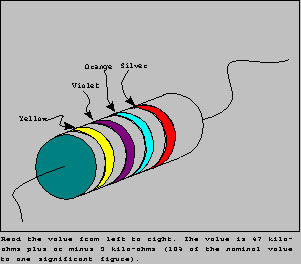
Purpose: To use three different measuring instruments to measure and compare resistances.
<>Equipment List:Color Code:
Tolerance (i.e., nominal uncertainty)
None 20%
Silver 10%
Gold 5%
Red 2%
Brown 1%
Green 0.50%
Blue 0.25%
Violet 0.10%
Gery 0.05%
(No color present; just the
background
color of the body of the resistor) 20% (+ or - nominal value)
COLOR DIGIT MULTPLIER (i.e., power
of ten as the third color)
Black
0
0
Brown
1
1
Red
2 2
Orange
3
3
Yellow
4
4
Green
5 5
Blue
6 6
Violet
7 -2
Grey
8 -1
White
9
Holding the resistor so that the bands of color are located toward the left side of the resistor, the first and second colors give the two significant figures of the resistor's value (no decimal point between them). The third color from the left gives the power of ten. The fourth color (if it exists) is the tolerance value.

Procedure:
1. Measure the resistance of all three resistors with
the VOM, hand-held DMM, and HP DMM (use 2 wire mode). Perform a
discrepancy
test against each measurement compared to the nominal value stamped
with
the color code on the resistor. (Optional) Try a "four wire" resistance
test
for greater precision when using the HP DMM; compare the precision of
the
four wire measurement to the regular two wire. State whether the
measured
value lies within the most probable range determined from the tolerance
stamped on the resistor. Comment on the accuracy of the three measuring
instruments used. Understand what range setting on your instrument
gives
the most precise reading.
2. Measure your own resistance, from one hand to the
other;
examine how it can change as you change the tightness of your grip or
as
your hands become moist.
Conclusion:
Comment as to whether any of the meters consistently
lacked accuracy and in what range. Look for trends.
More:
Your instructor may choose to provide an assortment of
light bulbs, some working, some not. Learn to use an ohm meter to
perform
a continuity test to see which bulb works and which does not.